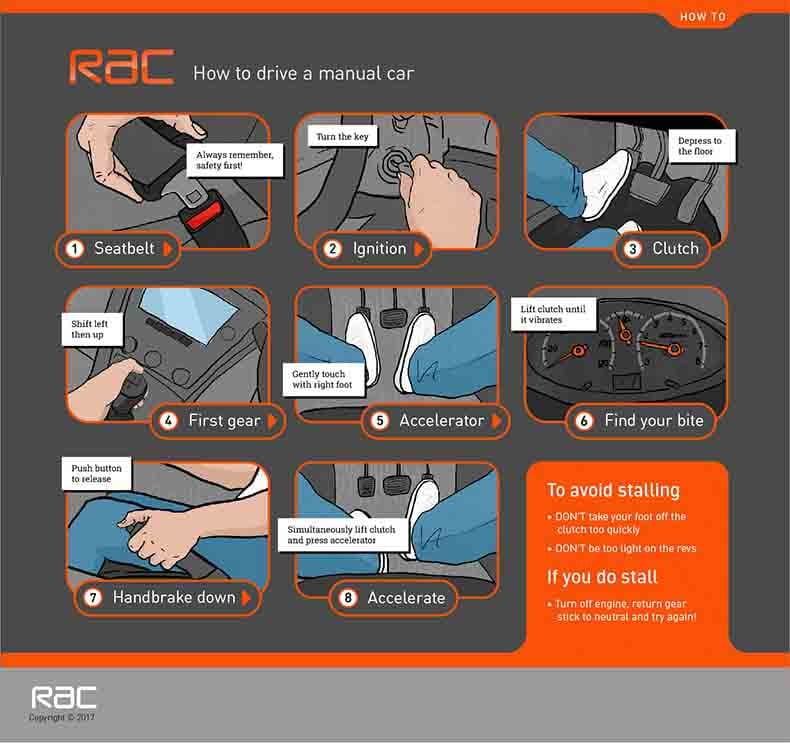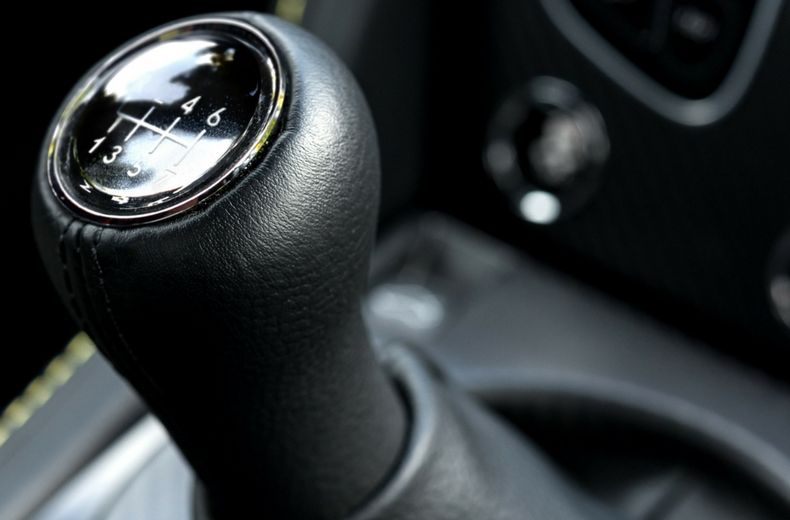Are you learning how to drive? If you are learning to drive a manual car read through our easy guide and find out how to do it in just a few steps.
(If you want to find out how to drive an automatic - check out our guide on how to drive an automatic car.)
Before you start
Typically, manual cars will have three pedals: clutch, brake and accelerator (in that order, left to right).
The brake and accelerator pedals are pretty simple - press the brake to slow down (the firmer you press it, the quicker you’ll lose speed), while using the accelerator increases the engine’s revs and causes you to speed up (the firmer you press it, the quicker you will speed up).
The clutch pedal is the one that makes driving a manual car more difficult than an auto.
Without going into too much detail, the clutch is essentially two metal plates that connect the engine to the drive wheels.
So by pressing down on the clutch pedal, you’re disconnecting the engine from the wheels.
How to drive a manual car

- Get in the car and put on your seatbelt
- Put the key in the ignition, check the gearbox is in neutral and then turn all the way until the engine starts
- Put the clutch pedal down with your left foot (this the pedal on the left)
- Move the gear stick into first gear
- Use your right foot to press down on the accelerator (pedal on the right) gently to increase the engine’s revs very slightly
- Slowly lift the clutch pedal using your left foot until it starts to vibrate gently
- This vibration is known as the car’s “bite point” - this is where the clutch plates start to come together.
- Release the handbrake and the car should start to move slowly
- Increase the revs while slowly raising your foot off the clutch unit you are moving forward with only the use of the accelerator pedal
Remember - if you’re too quick lifting your foot off the clutch, or don’t give it enough revs, the car will stall: that’s where the engine cuts out and the red lights glow on the dashboard.
If you stall, apply the brakes, turn the engine off, return the gear stick to neutral and begin the process again.

Cheaper than AA or we’ll beat by 20%^
• Roadside cover from £5.49 a month*
• We get to most breakdowns in 60 mins or less
• Our patrols fix 4/5 breakdowns on the spot

How to drive a manual car on a hill
To drive uphill in a manual car you'll often need to change to a lower gear otherwise you'll lose power. Depending on your speed, just change down a gear or two, and drive as normal.
You may find you need to put your foot down on the accelerator a little further than usual to achieve a normal level of speed when going uphill. Just be careful when you return to level ground, and be ready to ease off the accelerator and change to a higher gear.
To do a hill start, follow the instructions above, but you may want to engage the handbrake, rather than use the footbrake. This is so that you can use one foot for the clutch, and the other one for the accelerator as soon as possible, which will help you to avoid rolling backwards.
It's even more important to get the strongest bite possible when you're using the clutch on a hill start. Follow our full hill start guide here for more advice.
How to avoid damaging the clutch
Over time, you’ll get used to a car’s clutch and have a good understanding of where its bite point is, as well as how many revs you need to give it to move off.
It sounds complicated but you’ll develop a natural feel for it with practice.
If you’re not careful, though, it can be easy to wear the clutch out prematurely – and that’s likely to cost at least £300, rising well into four figures for some cars. Follow these tips and your clutch should easily last for well over 100,000 miles:
Don’t use the clutch to hold the car on hills or creep forward at junction
If you’re waiting at a junction, in traffic or at a roundabout, it’s tempting to hold the car at the clutch’s bite point, allowing you a quick getaway when you can move. But this can cause unnecessary wear, especially if you do it often.
Stop, put the handbrake on, and only use the clutch when you’re ready to pull away.
Don’t hold the clutch down when you’re stopped
Again, it’s tempting to leave your car in gear and keep your foot on the clutch when you’re stopped in traffic.
This puts a lot of pressure on the clutch release bearing, however, which could wear out quickly if you do it regularly.
Keep the revs to a minimum
To avoid stalling, especially during hilly manoeuvres, many drivers are too heavy with the accelerator.
This can cause unnecessary wear on the clutch plates.
You need a minimum amount of revs to get the car to move – and if you’re gentle enough, most cars can move without using the accelerator at all.
Black Box Insurance
Want to pay less for your car insurance? Whether you’re a new driver or just looking to reduce costs, we can help.


How many gears do manual cars have?
Years ago, was normal for manual cars to have just four gears.
In theory, this would make them easier to drive than the cars of today, but back then you’d also have to learn old-fashioned techniques such as double declutching as they didn’t have synchromesh gearboxes.
Gearboxes were also much vaguer than today, making it more difficult to find gears.
Today, most cars have at least five gears, although six gears are becoming increasingly common.
By having an extra-high sixth gear, the engine can run at little more than tickover during motorway cruising, helping reduce fuel consumption.
Seven-speed manual gearboxes are rare but they do exist – you can get one in supercars such as the Porsche 911 and Chevrolet Corvette.
For more information on passing your theory test and booking the practical driving test, visit our learning to drive section.
- Are graduated driving licences coming in?
- Did you know that we offer specialist learner driver insurance?
- Driving without shoes - is it illegal?
What are the advantages of manual gearboxes?
Whether you prefer manual or automatic gearboxes will come down to personal preference, but there are some clear advantages to driving a manual.
For a start, they’re generally cheaper to buy and better on fuel than automatics.
There are a number of reasons for this – automatic gearboxes are usually heavier than manuals, and traditional torque-converter auto ’boxes would waste energy building the resistance of hydraulic fluid to transfer drive from the engine to the wheels.
Manual gearboxes are generally better for those who like to feel in control, too.
If you’re planning an overtake, for example, in a manual you can drop down a gear in advance for a quick reaction when you need the acceleration.
In an automatic, there might be slight hesitation when you floor the accelerator.
Today, many automatics come with manual or sport modes for this situation, however.
The same applies in poor conditions such as driving across a muddy field or in the snow.
An automatic gearbox might get confused and select the wrong gear, spinning the wheels or struggling to maintain momentum.
In a manual, you can select a higher gear to increase torque, or slow down using the gears rather than the brakes, helping the driver remain in control.
How to 'heel-and-toe'
When you get used to driving a manual, you may wish to learn more advanced driving techniques such as how to “heel-and-toe”.
The name of this is actually a bit misleading – the pedal setup of cars used to mean you could increase the revs of the engine by toe-ing the brake pedal and blipping the throttle with your heel.
Today, it’s easier to rest the left of your right foot on the brake and blip the accelerator with the right half of your foot.
The benefit of this, when slowing down, is to enable you to rev match as you work down through the gearbox as you brake.
In truth, it’s a little unnecessary – during normal road driving, there’s little to be gained by doing this rather than slowing down using the brake before disengaging the clutch and selecting an appropriate gear, rather than overlapping braking and changing gear.
Once you’ve learned how to do it, however, it’s a satisfying skill – and if you ever take your car on a track day, it could shave seconds from your lap times.
If you’re thinking about doing it for the first time, it’s best to try it on private land without any other cars about and also read our step by step guide to attending your first track day.
After you've learned to drive a manual, it's worth looking at the RAC's breakdown cover product, which will give you complete peace of mind when you start driving in your own vehicle.
- How to drive an automatic car – step by step guide
- How much does it cost to learn to drive?
- RAC Temporary Car Insurance from 1 hour to 30 days
How to drive a manual car FAQs
- How to start a manual car
Put the key in the ignition and turn all the way until the engine starts. Put the clutch pedal down with your left foot. Move the gear stick into first gear. Use your right foot to press down on the accelerator gently to increase the engine’s revs very slightly. Slowly lift the clutch pedal until the engine starts to vibrate gently. Release the handbrake to start moving slowly. Increase the revs while slowly raising your foot off the clutch until you are moving forward with only the use of the accelerator pedal.
- Can you drive a manual car with an automatic licence?
No, you must pass your test in a manual car to be allowed to legally drive one. If you have a manual drivers licence, you are allowed to drive an automatic car though.
- How to drive a manual car on a roundabout
Driving a manual car on a roundabout can sometimes feel like you need an extra hand because you often need to steer, use your indicator, and change gears all at once. Take it slow, and make sure you shift up to at least 2nd gear once you’ve joined the roundabout. Once there, use your indicator before you start turning off at your exit, but not early enough for it to be mistaken for the previous exit. Then you can check your left mirror, make your exit, then shift up a gear to drive onwards if necessary.
- How long does it take to learn to drive a manual car?
If you are currently learning to drive, then you can expect to know how to drive a manual vehicle after 20-45 hours of training. This can vary depending on a variety of factors.
- Is it hard to drive a manual?
No, it is not difficult to learn to drive in a manual vehicle. Once you act instinctively, it is just as easy as an automatic. However, having a manual licence is a lot more useful, as it doesn’t limit the ability to drive in different types of vehicles.









